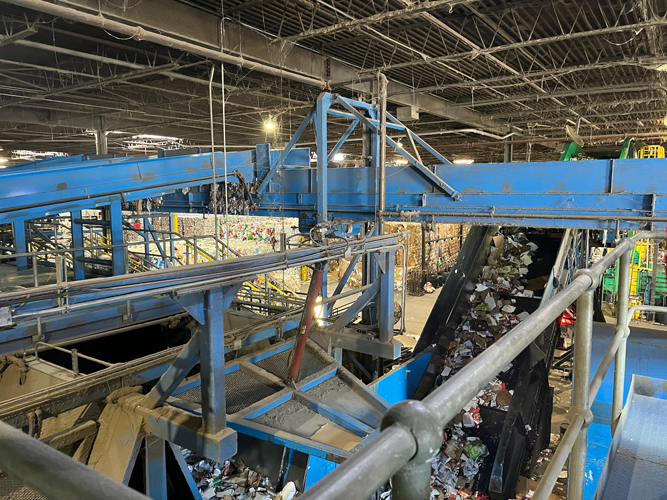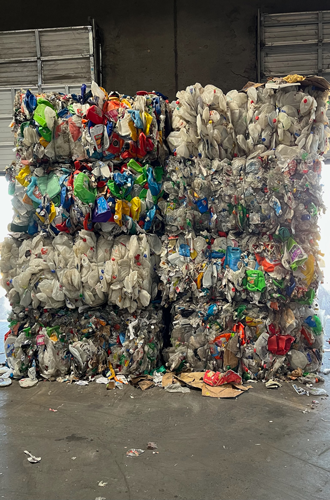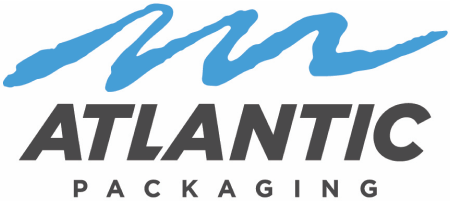Also, check out our Sustainability Terms Glossary, where we’ll add key terms from each of our Deep Dives over time. Bookmark this page for future reference!
In part 1 of this Deep Dive, we walked through the multi-faceted definition of “recyclable.” One of those factors is that the product be sortable so that it will be baled and sold to reprocessors with like materials. For paper and packaging, this sortation occurs at a facility called a MRF. In this part 2 of the Deep Dive, we’ll explore what MRFs are and how they work.
What is a MRF?
 A materials recovery facility, or MRF, is a solid-waste management plant that receives, sorts, separates, and prepares recyclable paper and packaging materials to sell to end-user manufacturers (we call them “reprocessors”). The end-user manufacturer will then use the recovered material (“feedstock”) to make new products.
A materials recovery facility, or MRF, is a solid-waste management plant that receives, sorts, separates, and prepares recyclable paper and packaging materials to sell to end-user manufacturers (we call them “reprocessors”). The end-user manufacturer will then use the recovered material (“feedstock”) to make new products.
Using both machines and people, materials flow through the MRF’s many steps and conveyor belts to be sorted by type of material (“stream”), further processed, and then similar materials are baled or compacted together to be sold and transported away from the MRF. As noted in part 1, MRFs almost always exclusively sort paper and packaging materials. Depending on the recycling facility, material streams usually include cardboard, mixed paper, aluminum and steel cans, and some kinds of plastic (most often, plastics #1, #2, and sometimes #5). As explained in part 1, the packaging material that a MRF chooses to collect depends heavily on their ability to effectively sort the material and whether there are strong end markets for those materials. MRFs usually need to be profitable in order to stay in business, so these end markets are critical.
Glass is also a common material stream; however, because of its vulnerability to breakage, glass is sometimes viewed by MRFs as a contaminant. Broken glass easily makes its way into other material streams and reduces their quality or renders them unusable; it can also damage sorting machinery. Glass is heavy and expensive to transport, and some communities may not have end markets for recycled glass, making it difficult for MRFs to justify processing it. We will dive further into other forms of contamination in MRFs below.
Traveling Through the MRF
In a typical MRF in the U.S., the process of sorting and recycling materials involves several key steps: collection and delivery; receiving and pre-sorting; sorting; baling and compaction; quality control; and transportation to end users. While these overall steps are by and large the same from MRF to MRF, it’s important to note that MRFs often look quite different from each other. The biggest variance from facility to facility is in the level of sophistication of sortation equipment. Some have a lot of automation, while others are much more manual. Additionally, some are very large while others are tiny. Some are privately run, while others are operated by municipalities. The descriptions below describe the “average” MRF in the U.S., but significant variability does exist.
1. Collection and Delivery: Recyclables are collected from residents’ curbside bins, designated drop-off locations, or commercial facilities (businesses, schools, etc.) and transported to the MRF. For curbside collection, residents separate recyclables – such as paper, cardboard, glass, plastics, and metals – from their general landfill-bound waste and place them in designated recycling bins. In the U.S., it is most common for recyclables to be collected “single stream,” meaning that all recyclables – paper, plastic, metal, etc. – are collected together (this is why we need MRFs – to do the separation!). The collection trucks, often equipped with compartments to keep trash and recyclables separate, pick up these recyclables on scheduled days and deliver them to the MRF.
In areas without curbside collection, or for materials not accepted in curbside programs, drop-off centers provide an alternative. Residents transport their recyclables to these drop-off locations, where they are typically sorted into different categories (e.g., glass, paper, electronics). Commercial facilities often generate larger volumes of recyclables and may set up contracted collection services. Public spaces, such as parks, streets, and bus stations, may have recycling bins for people to deposit items like bottles and cans. These bins are regularly emptied by municipal or contracted services.
In some cases, collected recyclables are first taken to a transfer station – a facility where materials are temporarily stored, sorted, and consolidated before being transported to a true recycling facility. This step is especially common in areas where MRFs are located far from collection points. In many cases, especially in urban areas, collection trucks deliver recyclables directly to the MRF, where the materials are unloaded and prepared for further processing. Once it arrives, the load of recyclables is typically dumped into a loading area, where it may be weighed and inspected. Weighing helps track the amount of material being processed, while an initial inspection allows for the identification of any obvious contaminants or non-recyclable items that may need to be removed before processing.
2. Receiving and Pre-Sorting: After arriving at the loading area, materials often go through preliminary sorting to remove large contaminants and non-recyclable items. A mechanical shovel usually feeds the material onto conveyor belts that transport items through each step of the recycling process.
At this stage, workers will observe the materials as they move along the conveyor belt and remove common contaminants like plastic bags, clothing, diapers, candy wrappers, expanded polystyrene (such as packaging foam), garden hoses, food scraps, holiday lights, hazardous materials like propane tanks and batteries, etc. Several of these items pose a danger to recycling facilities by potentially causing fires, tangling machinery, and disrupting operations. These contaminates interfere with the “good” recyclables and divert a lot of the MRF’s monetary and human resources toward sorting and disposing of these items. Another huge challenge at this stage includes products that tend to cross-contaminate streams (e.g., plastic products mixed with food residue). This cross-contamination can impair the efficiency of the sorting process, possibly hindering the identification of materials, and reducing the purity of the recycled material, making it less valuable or even unusable for recycling. Initial sorting ensures materials are ready for the MRF’s more detailed sorting and processing steps.
3. Sorting: Once initial contaminants have been sorted out, the material will be carried by conveyor belts through various sorting stages. Sorting may be done by people, machines, or both. In many facilities, materials will run through multiple automated machines to be separated into their specific streams (e.g., plastics, metals, paper, etc.). Mechanical sorting can include screening and other types of separation:
- Screens: Rotating or vibrating screens separate materials based on size. Larger recyclables will bounce across the top of the screens and continue traveling through the MRF to be further sorted. Any item under approximately three inches in at least two dimensions will likely fall through the gaps in the screens and be sent with other waste to landfill, as the item is too small to make it through the rest of the recycling process. (Click Here to See a MRF Screen in Action!)
- Air Classifiers: Air classifiers work by passing a stream of air through a mixture of materials and sorting them by density. The air flow causes lighter materials (paper and light plastics) to be lifted and carried away from heavier materials (metals, glass, and heavier plastics), which fall out of the air stream. The heavier items will fall into a specific collection chute, or they may be diverted to a separate conveyor belt to go through additional sorting technology. For example, heavy materials may run through magnets to sort any recyclable metals. Lighter items will undergo further sorting through optical sorters (detailed below) or manual quality checks.
- Magnetic Separators: Magnets may be used to remove ferrous metals (metals containing iron like steel) from the heavier item stream. (Click Here to See a Magnetic Separator!)
- Eddy Current Separators: These use magnetic fields to separate non-ferrous metals (metals that do not contain iron, like aluminum) from other materials.
- Optical sorters: One of the more recent innovations, particularly for plastics, is the optical sorter, which uses cameras or light-emitting near-infrared (NIR) lasers to automatically sort lighter solid items based on their color, shape, size, and other characteristics. Optical sorters may be used at multiple stages in the recycling process to separate paper and plastic materials from one another and ensure accuracy and quality. Some other advanced technologies use AI-empowered robotics to identify and separate materials.
- Manual sortation: Workers are usually stationed throughout the long process to help with sortation. They may be supplementing the work that machines, like the ones above, are doing, and they may also be doing some quality control along the way, removing contaminants or re-sorting items that the machines mis-sorted.
A MRF will likely use a combination, if not all, of these technologies in one facility to thoroughly separate materials. At the sorting stage, any contaminants (like plastic bags and string lights) that were not taken out during initial sorting may tangle or clog the machinery, causing delays and posing a physical risk to employees that climb into the machinery to remove these items.
By using these sorting technologies, recycling facilities can produce more uniform and uncontaminated material streams, which are easier to process in later recycling stages where the materials have reached their end markets.
 4. Baling and Compaction: Once fully sorted, materials are compacted into bales or other forms for easier handling and transportation. Each type of material is baled separately (e.g., paper, cardboard, plastics, metals). Paper and cardboard are typically baled into separate dense, rectangular blocks, while plastics are usually baled separately by type (e.g., PET, HDPE). Depending on the material type, heavier materials may be compacted into bales (in the case of metals) or crushed (in the case of glass) to reduce their volume and prepare them for transportation to end market processing facilities.
4. Baling and Compaction: Once fully sorted, materials are compacted into bales or other forms for easier handling and transportation. Each type of material is baled separately (e.g., paper, cardboard, plastics, metals). Paper and cardboard are typically baled into separate dense, rectangular blocks, while plastics are usually baled separately by type (e.g., PET, HDPE). Depending on the material type, heavier materials may be compacted into bales (in the case of metals) or crushed (in the case of glass) to reduce their volume and prepare them for transportation to end market processing facilities.
5. Quality Control: Throughout the entire recycling process, from initial intake to inspecting finished bales, there are quality control checks to ensure that contaminants and non-recyclable materials are removed. Sometimes this QC is done by humans, and in some MRFs with newer technology, robots may also be helping with QC. This helps in maintaining the quality of the recyclables and avoiding contamination of the final products. This also allows MRFs to receive a higher price for their materials.
(See the Quality Control Process Here!)
6. Transportation to End Users: Baled materials are sold to various end users. Once materials are baled, they are loaded onto trucks or containers and transported to specialized recycling facilities or end markets where the recyclable materials are then processed to meet industry quality standards. For example, metals might be sent to smelters where they are melted down and reformed into new products, while glass might be sent to a glass recycling facility to be ground or melted and reformed into new glass products. Plastics may be shredded and melted down into pellets to be turned back into plastic products, like beverage bottles.
Overall, MRFs use a combination of mechanical processes and manual labor to sort and prepare recyclable materials for further processing, making it possible to recover valuable materials and reduce waste sent to landfills.
The Economics
While MRFs can be funded by a mix of public and private sources, most MRFs rely heavily on the revenue collected from recyclables to support their operations and ensure they can effectively manage and process recyclable materials. Facilities that can effectively sort and process large volumes of recyclables and maintain high-quality output are generally more financially sustainable than those bogged down by contamination, or those who use more manual sorting methods. This is why MRFs tend to recycle very specific materials and avoid the difficult-to-collect and recycle materials, like glass.
To add to that point, MRFs pay a fee to landfills to dispose of their non-recyclable waste (contaminants) or residuals that could not be processed or sold, called a “tipping fee.” Essentially, the MRF’s trucks must pay to “tip” the trash off their trucks into the landfill. The fee will be higher if there are more bulky and hazardous items (propane tanks, batteries, etc.). Disposal fees like this create some of the highest costs for MRFs and divert tons of resources from actually recycling materials. If a bale becomes contaminated with something like broken glass, the MRF likely won’t receive any revenue, and instead, may pay a tipping fee to dispose of the bale because it is unusable. This exemplifies why consumer education is so important to avoid contamination upfront.
The Future for MRFs:
Based on the U.S. Environmental Protection Agency’s (EPA) 2018 data, over 292.4 million tons of municipal solid waste is generated in the U.S., and about 94 million tons, or 32% of that, is recycled and turned into new products. For those who are skeptical if recycling actually happens in the U.S., this rate marks an improvement from our previous national recycling rate of less than 7% in 1960. To improve our rates even further, the EPA recently set a goal to reach a 50% national recycling rate by 2030. In order to reach that goal, there needs to be increased funding opportunities for MRFs, infrastructure upgrades to improve sorting accuracy and efficiency, and improved consumer education to ensure the right materials make it to MRFs in the first place. As we’ve described, the technology and efficiency of the MRF play a crucial role in sorting paper and packaging. Advanced MRFs with state-of-the-art sorting technology can handle a wider variety of materials and complex products, improving the recyclability of those items. Older or less advanced facilities may struggle to sort certain products, leading to lower recycling rates.
Paper and cardboard make up the highest portion of recycled material in the U.S., while plastic has the lowest recycling rate. With these more efficient sorting technologies, we can increase the recycling rate of traditionally hard to recycle materials, like plastic, which will ultimately bring us closer to the EPA’s 50% recycling goal and divert these materials from wreaking havoc in landfills and our environment.
Additional Resources:
- YouTube video of a virtual MRF tour – Skip to 1:10 for the beginning of the virtual MRF tour (please keep in mind that each MRF is different and may not go through the same exact steps or handle the same materials as the one shown in the video)
- Dive deeper into EPR’s role, recycling laws and incentives, and regulatory information
